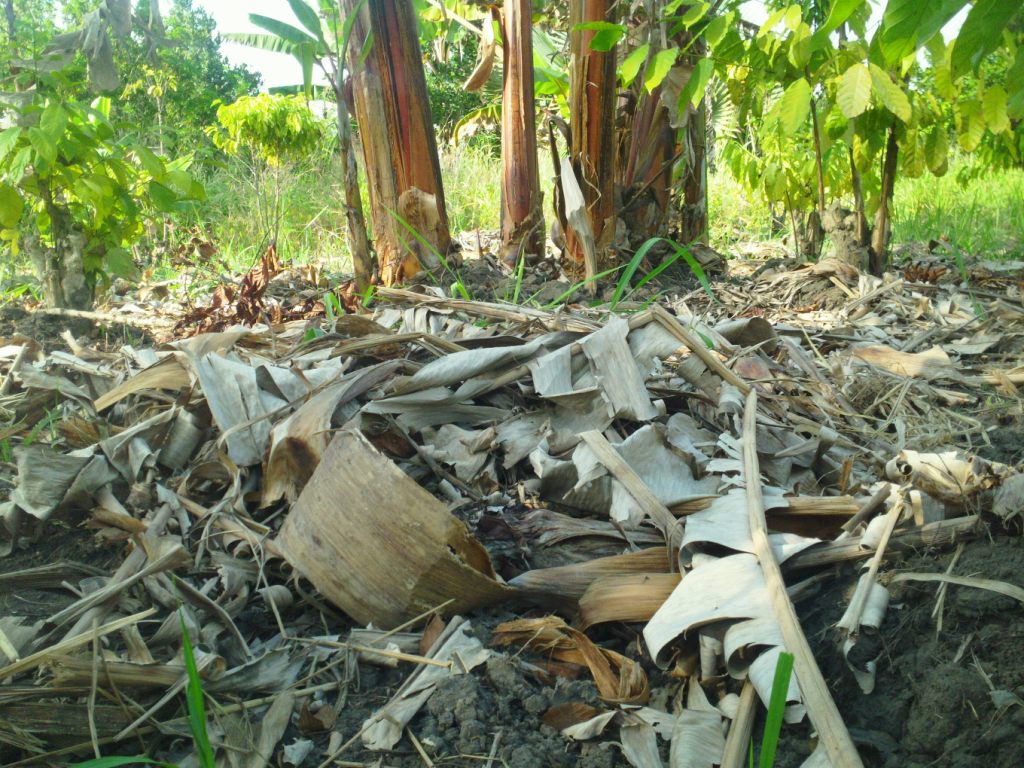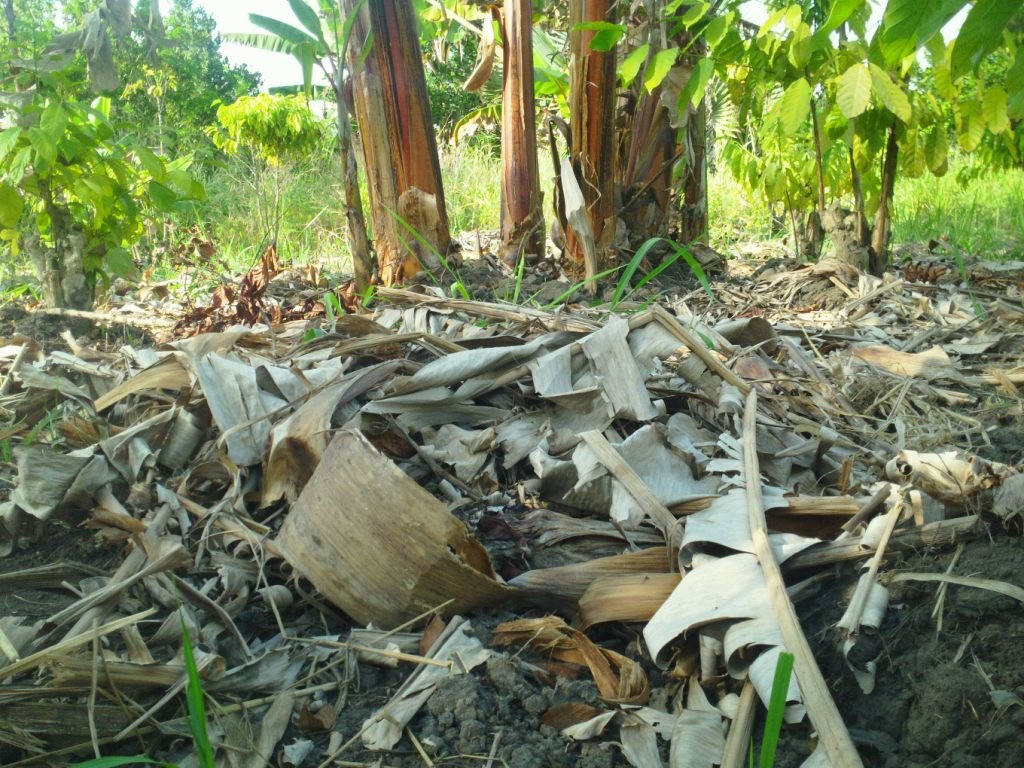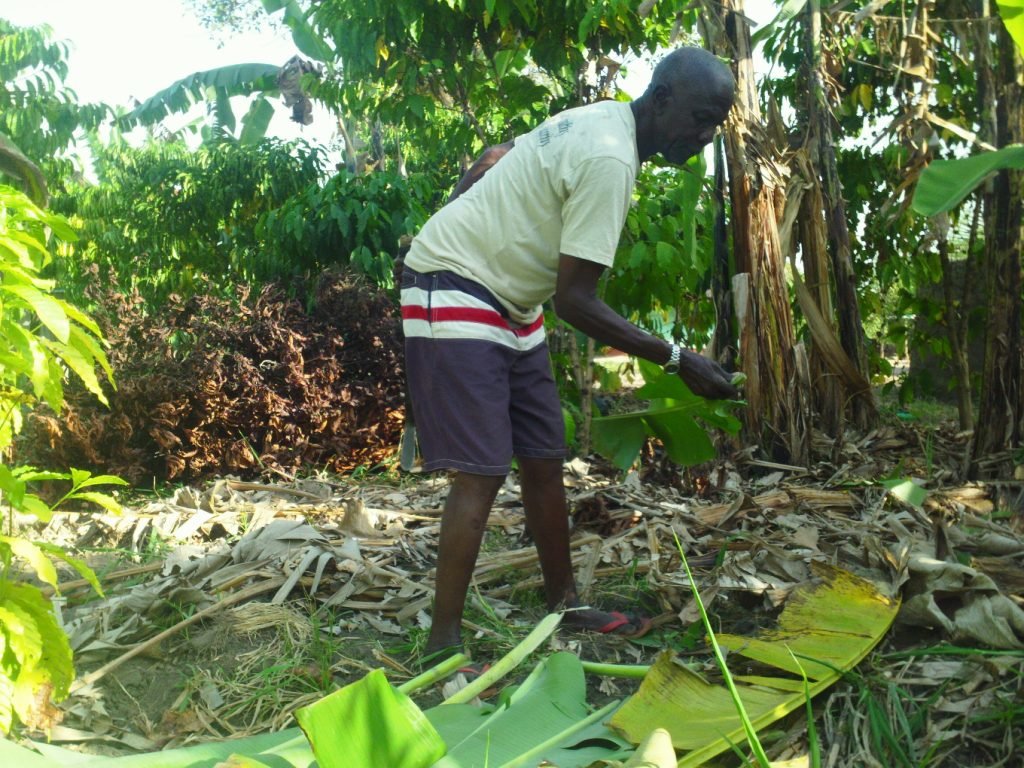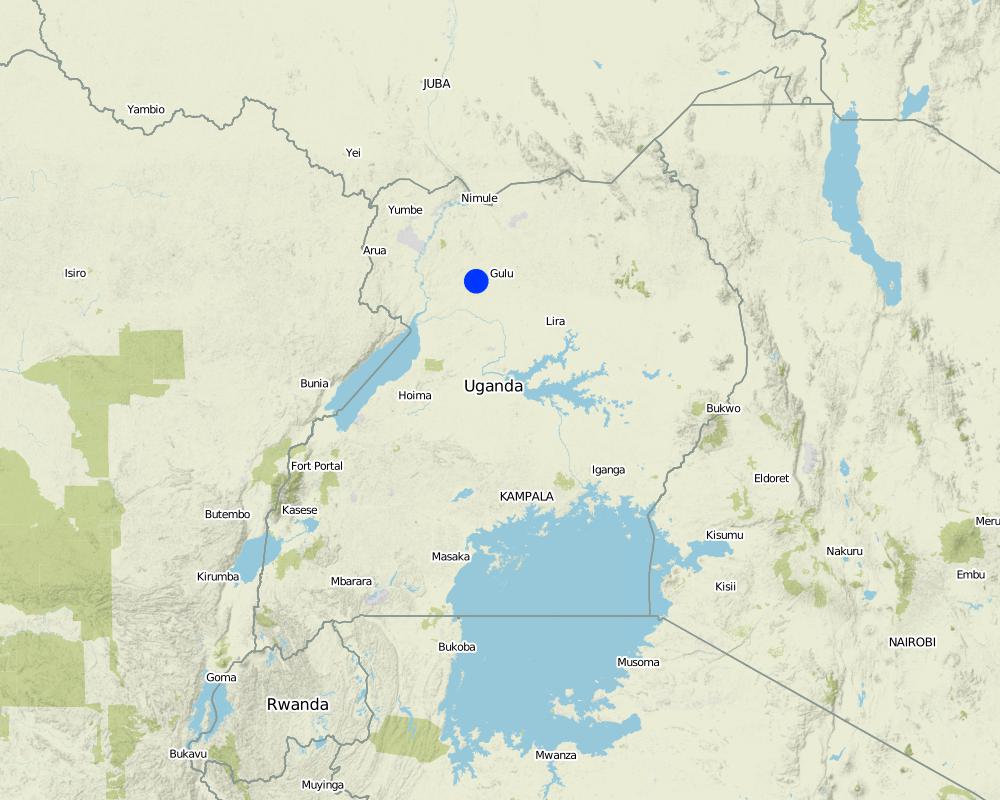Mulching using banana leaves [Uganda]
- Creation:
- Update:
- Compiler: Kamugisha Rick Nelson
- Editors: Bernard Fungo, Sunday Balla Amale, Richard Otto Kawawa, JOY TUKAHIRWA
- Reviewers: Stephanie Jaquet, Renate Fleiner, Nicole Harari, Drake Mubiru, Donia Mühlematter, Alexandra Gavilano
Labolo Ma Kipo Mwanyi
technologies_2757 - Uganda
View sections
Expand all Collapse all1. General information
1.2 Contact details of resource persons and institutions involved in the assessment and documentation of the Technology
Key resource person(s)
land user:
Ongai Andrew
Farmer
Uganda
1.3 Conditions regarding the use of data documented through WOCAT
The compiler and key resource person(s) accept the conditions regarding the use of data documented through WOCAT:
Yes
1.4 Declaration on sustainability of the described Technology
Is the Technology described here problematic with regard to land degradation, so that it cannot be declared a sustainable land management technology?
No
Comments:
The farmer confessed that when he uses dry banana leaves, the leaves rot and provides manure which is utilized by bananas retaining the moisture content in the soil.
2. Description of the SLM Technology
2.1 Short description of the Technology
Definition of the Technology:
Dry banana leaves are spread in the soil for growing banana plantation for improving soil fertility and moisture content retention.
2.2 Detailed description of the Technology
Description:
Locally obtained dry banana leaves is a low cost mulching material used by farmers in Northern Uganda to mulch soil in order to grow banana with the aim of improving soil fertility and soil moisture content retention.
The land user identifies a banana plantation usually 0.5 to 2 acres planted with sweet banana, Bogoya, Fear 17 varieties and spread the banana leaves across the banana plantation usually below 40-60 cm to the mother plant using 2-4 people per day, hoes and pangas.
Mulching is preferred because it uses locally available banana leaves within the plantation. It does not require high maintenance costs to pay for labor, digging and transport. Costs would be incurred transporting the mulching material. In addition to conserving moisture in the soils, it reduces water runoff to avoid erosion and improves the soil as the mulch material rots.
However, it is important for the land user to be aware that mulching using banana leaves serve as breeding place for banana weevils and if the land user places the mulch too close to the mother plant it will affect the growth of the young suckers. This therefore means land users who need to use this low cost mulching material need to first work out proper procedures with the extension worker on how to mulch banana plantation before mulching.
To sustain this technology, the land users can integrate cultivating multipurpose tree species (Calliandra and Grivellea) to additionally stabilize the soils and improve soil fertility when the tree mature and leaves litter.
2.3 Photos of the Technology
2.4 Videos of the Technology
Comments, short description:
Video on mulching using banana leaves in Nwoya District.
Date:
24/05/2017
Location:
Bwobo village, Bowbo parish, Alero Sub-county Nwoya District.
Name of videographer:
Issa Aiga
2.5 Country/ region/ locations where the Technology has been applied and which are covered by this assessment
Country:
Uganda
Region/ State/ Province:
Northern Region,Uganda
Further specification of location:
Nwoya District
Specify the spread of the Technology:
- evenly spread over an area
If precise area is not known, indicate approximate area covered:
- < 0.1 km2 (10 ha)
Comments:
Map showing technology site in Northern Uganda.
Map
×2.6 Date of implementation
Indicate year of implementation:
2012
If precise year is not known, indicate approximate date:
- less than 10 years ago (recently)
2.7 Introduction of the Technology
Specify how the Technology was introduced:
- through projects/ external interventions
Comments (type of project, etc.):
Supported by Nothern Uganda Social Action Fund (NUSAF) with training on how to mulch using banana leaves.
3. Classification of the SLM Technology
3.1 Main purpose(s) of the Technology
- improve production
- reduce, prevent, restore land degradation
- mitigate climate change and its impacts
3.2 Current land use type(s) where the Technology is applied

Cropland
- Annual cropping
- Perennial (non-woody) cropping
- Tree and shrub cropping
Perennial (non-woody) cropping - Specify crops:
- banana/plantain/abaca
Tree and shrub cropping - Specify crops:
- coffee, open grown
Number of growing seasons per year:
- 2
Comments:
The land user grows coffee and Banana for home consumption and sale.
3.4 Water supply
Water supply for the land on which the Technology is applied:
- rainfed
3.5 SLM group to which the Technology belongs
- minimal soil disturbance
- integrated soil fertility management
- water harvesting
3.6 SLM measures comprising the Technology

agronomic measures
- A1: Vegetation/ soil cover
- A2: Organic matter/ soil fertility

structural measures
- S7: Water harvesting/ supply/ irrigation equipment
Comments:
Technology involves spreading/ laying out of the mulching material for soil moisture retention and soil fertility improvement.
3.7 Main types of land degradation addressed by the Technology

soil erosion by water
- Wt: loss of topsoil/ surface erosion
- Wg: gully erosion/ gullying

soil erosion by wind
- Et: loss of topsoil

chemical soil deterioration
- Cn: fertility decline and reduced organic matter content (not caused by erosion)

physical soil deterioration
- Pc: compaction

biological degradation
- Bc: reduction of vegetation cover

water degradation
- Hs: change in quantity of surface water
- Hg: change in groundwater/aquifer level
3.8 Prevention, reduction, or restoration of land degradation
Specify the goal of the Technology with regard to land degradation:
- prevent land degradation
- reduce land degradation
Comments:
Decomposition of mulched material increases fertility in turn responding to reduced land degradation.
4. Technical specifications, implementation activities, inputs, and costs
4.1 Technical drawing of the Technology
Author:
Kaheru
Date:
27/05/2017
4.2 General information regarding the calculation of inputs and costs
Specify how costs and inputs were calculated:
- per Technology area
Indicate size and area unit:
2 acres
other/ national currency (specify):
UGX
If relevant, indicate exchange rate from USD to local currency (e.g. 1 USD = 79.9 Brazilian Real): 1 USD =:
3200.0
Indicate average wage cost of hired labour per day:
5000
4.3 Establishment activities
| Activity | Timing (season) | |
|---|---|---|
| 1. | Site selection | Once before before establishment |
| 2. | look for inputs (labour) | Once before establishment |
| 3. | Cut the banana leaves | During establishment |
| 4. | Lay the banana leaves | During establishment |
Comments:
Cutting banana leaves and spreading them can be a routine activity that the farmer continues to do.
4.4 Costs and inputs needed for establishment
| Specify input | Unit | Quantity | Costs per Unit | Total costs per input | % of costs borne by land users | |
|---|---|---|---|---|---|---|
| Labour | Persons days employed on monthly basis | persons | 10.0 | 70000.0 | 700000.0 | 100.0 |
| Equipment | Hoes | Pieces | 10.0 | 10000.0 | 100000.0 | 100.0 |
| Equipment | Pangas | Pieces | 5.0 | 7000.0 | 35000.0 | 100.0 |
| Other | Training costs (transport) | sessions | 3.0 | 30000.0 | 90000.0 | 100.0 |
| Total costs for establishment of the Technology | 925000.0 | |||||
Comments:
The money that the farmer use for these activities is income received from the sale of banana.
4.5 Maintenance/ recurrent activities
| Activity | Timing/ frequency | |
|---|---|---|
| 1. | Re-mulching | Twice a year |
4.6 Costs and inputs needed for maintenance/ recurrent activities (per year)
| Specify input | Unit | Quantity | Costs per Unit | Total costs per input | % of costs borne by land users | |
|---|---|---|---|---|---|---|
| Labour | Persons days on monthly basis | Persons | 4.0 | 150000.0 | 600000.0 | 100.0 |
| Fertilizers and biocides | 100.0 | |||||
| Total costs for maintenance of the Technology | 600000.0 | |||||
Comments:
High costs of labour for estsblishment activities with more tasks compared to maintenance costs which are rather low.
4.7 Most important factors affecting the costs
Describe the most determinate factors affecting the costs:
Labour for cutting and laying the banana leaves is the most important factor affecting costs.
5. Natural and human environment
5.1 Climate
Annual rainfall
- < 250 mm
- 251-500 mm
- 501-750 mm
- 751-1,000 mm
- 1,001-1,500 mm
- 1,501-2,000 mm
- 2,001-3,000 mm
- 3,001-4,000 mm
- > 4,000 mm
Specify average annual rainfall (if known), in mm:
1450.00
Specifications/ comments on rainfall:
More rains during the wet season (March-May) with long dry spell around June - August.
Agro-climatic zone
- humid
5.2 Topography
Slopes on average:
- flat (0-2%)
- gentle (3-5%)
- moderate (6-10%)
- rolling (11-15%)
- hilly (16-30%)
- steep (31-60%)
- very steep (>60%)
Landforms:
- plateau/plains
- ridges
- mountain slopes
- hill slopes
- footslopes
- valley floors
Altitudinal zone:
- 0-100 m a.s.l.
- 101-500 m a.s.l.
- 501-1,000 m a.s.l.
- 1,001-1,500 m a.s.l.
- 1,501-2,000 m a.s.l.
- 2,001-2,500 m a.s.l.
- 2,501-3,000 m a.s.l.
- 3,001-4,000 m a.s.l.
- > 4,000 m a.s.l.
Indicate if the Technology is specifically applied in:
- concave situations
5.3 Soils
Soil depth on average:
- very shallow (0-20 cm)
- shallow (21-50 cm)
- moderately deep (51-80 cm)
- deep (81-120 cm)
- very deep (> 120 cm)
Soil texture (topsoil):
- medium (loamy, silty)
Soil texture (> 20 cm below surface):
- medium (loamy, silty)
Topsoil organic matter:
- medium (1-3%)
5.4 Water availability and quality
Ground water table:
< 5 m
Availability of surface water:
good
Water quality (untreated):
good drinking water
Is water salinity a problem?
No
Is flooding of the area occurring?
No
5.5 Biodiversity
Species diversity:
- low
Habitat diversity:
- low
5.6 Characteristics of land users applying the Technology
Sedentary or nomadic:
- Sedentary
Market orientation of production system:
- mixed (subsistence/ commercial)
Off-farm income:
- less than 10% of all income
Relative level of wealth:
- poor
Individuals or groups:
- individual/ household
Level of mechanization:
- manual work
Gender:
- women
- men
Age of land users:
- youth
- middle-aged
5.7 Average area of land used by land users applying the Technology
- < 0.5 ha
- 0.5-1 ha
- 1-2 ha
- 2-5 ha
- 5-15 ha
- 15-50 ha
- 50-100 ha
- 100-500 ha
- 500-1,000 ha
- 1,000-10,000 ha
- > 10,000 ha
Is this considered small-, medium- or large-scale (referring to local context)?
- small-scale
5.8 Land ownership, land use rights, and water use rights
Land ownership:
- communal/ village
Land use rights:
- individual
Water use rights:
- individual
5.9 Access to services and infrastructure
health:
- poor
- moderate
- good
education:
- poor
- moderate
- good
technical assistance:
- poor
- moderate
- good
employment (e.g. off-farm):
- poor
- moderate
- good
markets:
- poor
- moderate
- good
energy:
- poor
- moderate
- good
roads and transport:
- poor
- moderate
- good
drinking water and sanitation:
- poor
- moderate
- good
financial services:
- poor
- moderate
- good
- poor
- moderate
- good
6. Impacts and concluding statements
6.1 On-site impacts the Technology has shown
Socio-economic impacts
Production
crop production
Comments/ specify:
As result of integration and application of manure from littered leaves of banana.
land management
Comments/ specify:
The farmer uses mulch material from the same garden that is mulching.
Income and costs
expenses on agricultural inputs
Comments/ specify:
Expenses only incurred on purchase of pangas which are not high. Labour costs are high.
farm income
Comments/ specify:
From the sale of matooke.
workload
Comments/ specify:
Reduced labour and costs required on farm after mulching.
Socio-cultural impacts
food security/ self-sufficiency
Comments/ specify:
With Mulching , the farmer is able to realise more bananas produced which makes him food secure. Even the money obtained from sale of banana is used to buy food like posho and beans.
national institutions
Comments/ specify:
Especially with NUSAF which supported the farmer with trainings.
SLM/ land degradation knowledge
Comments/ specify:
Trained by Northern Uganda Social Action Fund (NUSAF) and extension workers on mulching using bananas.
Ecological impacts
Water cycle/ runoff
harvesting/ collection of water
Comments/ specify:
Retained by mulch material.
surface runoff
Soil
soil moisture
soil cover
Comments/ specify:
Due to mulch material.
soil organic matter/ below ground C
Comments/ specify:
Due to decomposed mulch.
Climate and disaster risk reduction
landslides/ debris flows
6.2 Off-site impacts the Technology has shown
water availability
Comments/ specify:
Retained by the mulch material.
6.3 Exposure and sensitivity of the Technology to gradual climate change and climate-related extremes/ disasters (as perceived by land users)
Gradual climate change
Gradual climate change
| Season | increase or decrease | How does the Technology cope with it? | |
|---|---|---|---|
| annual temperature | increase | moderately | |
| seasonal temperature | dry season | increase | |
| annual rainfall | increase | moderately |
Climate-related extremes (disasters)
Climatological disasters
| How does the Technology cope with it? | |
|---|---|
| drought | moderately |
6.4 Cost-benefit analysis
How do the benefits compare with the establishment costs (from land users’ perspective)?
Short-term returns:
slightly positive
Long-term returns:
positive
How do the benefits compare with the maintenance/ recurrent costs (from land users' perspective)?
Short-term returns:
positive
Long-term returns:
positive
Comments:
Benefits are low in the short term with more labour costs for cutting and laying grass mulch while in the long run, less labour costs and more benefits (reduced soil erosion, increased production) resulting from decomposed mulch material.
6.5 Adoption of the Technology
- 1-10%
If available, quantify (no. of households and/ or area covered):
4
Of all those who have adopted the Technology, how many did so spontaneously, i.e. without receiving any material incentives/ payments?
- 0-10%
6.6 Adaptation
Has the Technology been modified recently to adapt to changing conditions?
Yes
If yes, indicate to which changing conditions it was adapted:
- changing markets
Specify adaptation of the Technology (design, material/ species, etc.):
Established a local collection centre for marketing bananas to avoid exploitation.
6.7 Strengths/ advantages/ opportunities of the Technology
| Strengths/ advantages/ opportunities in the land user’s view |
|---|
| Good for soil moisture retention and soil fertility improvement. |
| Maintenance costs are low in the long run. |
| Uses locally available mulch material which is easily accessible in the plantation. |
| Strengths/ advantages/ opportunities in the compiler’s or other key resource person’s view |
|---|
| The technology is appropriate for both small scale and large scale land users with a banana plantation. |
| The technology can easily be promoted and replicated by other farmers in other areas. |
| Once established, its easy to manage and mentain as long as labour is available at affordable cost. |
6.8 Weaknesses/ disadvantages/ risks of the Technology and ways of overcoming them
| Weaknesses/ disadvantages/ risks in the land user’s view | How can they be overcome? |
|---|---|
| Prolonged drought affects the banana which may affect the quantity and quality of mulching material. | Integrate agrofrestry trees within the banana plantation (Grivellea and Calliandra). |
| Labour Intensive associated with high costs in case the farmer has 10 acres and more. | Work in groups and exchange labour. |
| Wind affects banana production which may affect the quality of mulching material. | Promote agroforestry trees (Callindra, Grivellea 0 within the technology to acts as soil fertility improving trees and wind breaks. |
| Weaknesses/ disadvantages/ risks in the compiler’s or other key resource person’s view | How can they be overcome? |
|---|---|
| Prolonged drought affects the Banana yield and therefore may not be a solution to poor farmers, | Promote agroforestry tree planting (calliandra, Grivellea) that addresses climatic change issues. |
| Requires a lot of labour. | Engage labour on monthly basis. |
| Attract thieves who may want to eat and sell. |
Strengthen Community local bylaws. If found stealing or encroaching pay 2 times the equivalent of what has been stolen. |
| The technology is mostly affected by wind. | Promote agroforestry trees as wind breakers on the farm. |
7. References and links
7.1 Methods/ sources of information
- field visits, field surveys
01
- interviews with land users
01
When were the data compiled (in the field)?
24/04/2017
Links and modules
Expand all Collapse allLinks
No links
Modules
No modules





